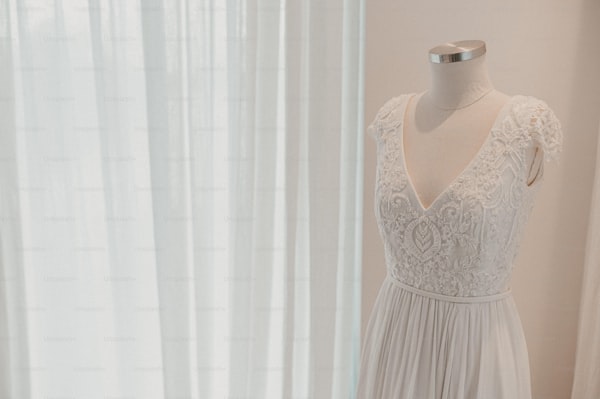Essential Considerations for Crafting a Wedding Dress with a Flowing Chiffon Skirt
Exploring the Beauty and Elegance of Chiffon Wedding dresses
Wedding dresses come in countless styles and fabrics, but one of the most alluring choices for brides is the flowing chiffon skirt. This fabric not only adds a soft, romantic touch to a wedding ensemble but also allows for beautiful movement that accentuates the bride's grace. If you're contemplating the creation of a wedding dress featuring a chiffon skirt, there are several considerations to keep in mind to ensure that the final garment captures the essence of your vision.
Understanding Chiffon: The Fabric of Choice
Chiffon is a lightweight, sheer fabric that is often composed of silk or polyester. Its delicate nature allows it to drape elegantly, making it a popular choice for Wedding dresses. However, the fabric also presents specific challenges for designers and seamstresses, which need to be addressed. Here are some factors to consider:
- Texture and Layering: Chiffon can be slightly slippery, which may complicate sewing and draping. It often requires underlayers, such as satin or tulle, to give it structure while maintaining its flowing quality.
- Color Choices: Although chiffon is available in various hues, certain colors may appear different in varying lights. It is essential to test the fabric in natural and artificial lighting to achieve the desired shade.
- Comfort and Breathability: As weddings often last several hours, ensuring the dress is comfortable is imperative. Consider using breathable linings and designing the skirt to allow for optimal airflow.
Design Elements to Incorporate
When designing a wedding dress with a chiffon skirt, the overall silhouette and style play crucial roles. Here are some aspects to incorporate:
| Design Element | Description |
| A-Line Silhouette | Offers a flattering cut for most body types, flowing gently from the waist down. |
| Illusion Neckline | Creates a romantic look while providing support and enhancing the flow of the chiffon. |
| Embellishments | Delicate details such as embroidery, rhinestones, or lace can elevate the design without overwhelming the chiffon’s softness. |
| Train Length | A longer train can enhance the dramatic effect of the flowing chiffon while adding elegance. |
Additional Considerations for Chiffon Wedding dresses
Aside from the fabric choice and design elements, it’s important to consider some additional aspects when crafting a wedding dress with a flowing chiffon skirt:
Bridal Body Types
Different body types require different design approaches. Here’s a quick guide to how chiffon skirts can complement various shapes:
- Hourglass: Emphasize the waist with fitted bodices that transition into a full chiffon skirt.
- Pear Shape: A-line chiffon skirts are ideal as they provide balance, accentuating the waist while skimming over the hips.
- Rectangle: Layers of chiffon can create curves, offering volume and structure through pleating or ruffles.
- Plus Size: A flowing chiffon skirt can flatter without constricting, particularly when combined with a structured bodice.
Season and Venue Considerations
The season and venue of the wedding can greatly influence the design and materials used for the chiffon skirt. Here’s what to keep in mind:
- Summer Weddings: Lightweight chiffon allows for breathability. Consider lighter colors and floral patterns.
- Winter Weddings: Consider layering the chiffon with a heavier fabric for warmth while still achieving a flowing look.
- Beach Weddings: A shorter chiffon skirt can provide ease of movement in sandy environments; opt for fabrics that resist wind.
- Formal Venues: Longer, more elegant chiffon skirts can enhance a formal aesthetic when paired with luxurious bodices.

Pro Tips for Creating Your Dream Chiffon Skirt
To ensure the chiffon skirt turns out perfectly, here are some professional tips:
- Mock-ups are Key: Always create a mock-up of the dress using less expensive fabric to ensure the design flows as intended.
- Quality Matters: Invest in high-quality chiffon to avoid issues such as fraying or fading over time.
- Sewing Techniques: Utilize specific sewing techniques, such as French seams or bias binding, to ensure a polished finish that prevents fraying.
- Professional Tailoring: If possible, consult a professional tailor who has experience with chiffon to achieve the best results.
FAQs About Chiffon Wedding dresses
If you’re still pondering over your chiffon wedding dress, you may have some common queries. Here are the answers to some frequently asked questions:
- How do I care for my chiffon wedding dress? Chiffon can be delicate, so follow the manufacturer's care instructions carefully. Dry cleaning is often recommended.
- Can chiffon be layered? Yes, layering chiffon can create depth and texture in your skirt, which can enhance the overall aesthetic.
- Are chiffon dresses suitable for all seasons? While lightweight for summer, chiffon can be layered for warmth in winter, making it versatile.
Conclusion: Final Thoughts on Designing a Chiffon Wedding Dress
Creating a wedding dress with a flowing chiffon skirt is a beautiful endeavor that combines elegance, craftsmanship, and personal style. By considering the fabric’s characteristics, the bride’s body type, the wedding season, and the specific design elements, you can create a stunning dress that perfectly represents the bride’s vision. Remember, a well-designed chiffon skirt can elevate any wedding dress and impart a sense of grace and romance to one of life’s most special days. Should you have any further queries or needs regarding the designing process, seeking professional guidance will often yield the best results. Your wedding dress is a testament to your style—choose wisely and make it an unforgettable masterpiece.